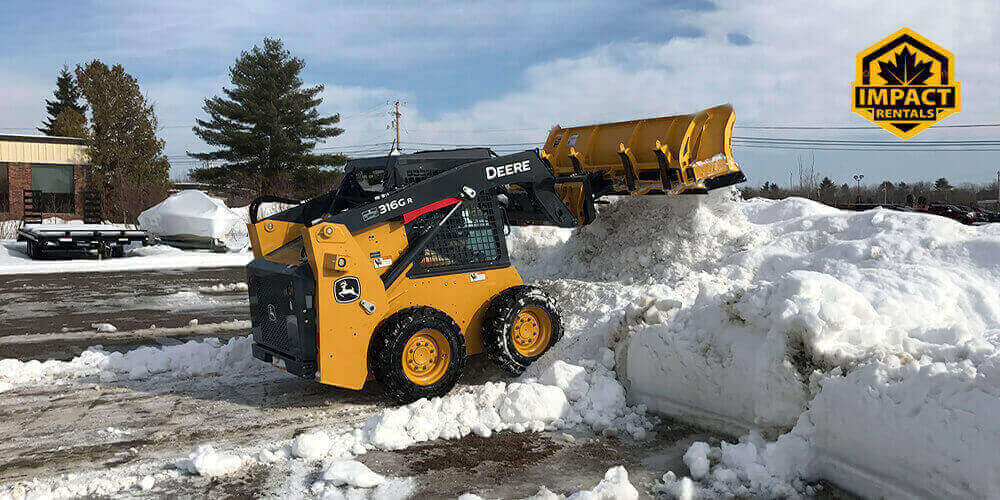
Tips for Using a Skid Steer in Winter
Skid steers are important equipment used in various industries. Whether in a construction, industrial, or landscaping application, they come in handy to complete our work seamlessly. But things change when winter comes. These machines are still important for our work, but keeping them running well during colder months gets harder. This article mentions some tips for using a skid steer in winter. Let’s get started!
Impact of Winter Weather on Skid Steers
Skid steers, or skid loaders, are powerful and compact machines that move materials in agriculture, construction, landscaping, and logistics. Their ability to switch various front-end attachments according to the task makes them incredibly functional, allowing operators to handle tasks easily. However, like any other equipment, skid steers also pose risks in cold weather and icy conditions, resulting in less efficiency.
- Tires: Cold temperatures cause tire pressure to drop, leading to underinflation.
- Fluids: The fluid viscosity will be affected by extreme weather conditions.
- Batteries: Winter weather can make it harder for batteries to maintain their charge. Ice, slush and road salt can cause wear and corrosion.
- Attachments: During winter, you have to use different attachments meant for snow removal to operate them smoothly.
Now, we will examine how you can prepare your skid steer and team for safe operation in winter.
Tips for Using a Skid Steer During Winter
1. Prepare for Winter Conditions in Advance
While planning your snow removal project, know when you’ll need a skid steer. Ensure that your team will work where the temperatures might be extreme. Even a single day of snowfall can lead to delays and increase the risk of accidents. Also, be aware of the updated local regulations and provide training for your team regarding the use of winter equipment and winter conditions. By doing this, we can avoid any risks and operate the equipment more safely.
2. Check and Change the fluids
Review your skid steer’s maintenance schedule and fill up the fluids exclusive to cold weather. Each of them are elaborated below:
- Engine Oil: Choose an oil viscosity that suits the outdoor temperature. For smoother cold-weather starts and better lubrication, use 5W-40 synthetic oil, which protects down to -40°F. If winter conditions are milder, you can use 10W-30, which works down to -20°F.
- Coolant Oil: Like antifreeze in a car or truck, antifreeze is an important lubricant for your skid steer. Use it before starting work to prevent freezing and overheating.
- Hydraulic Oil: Synthetic blends have better fluidity in cold weather. You’ll need a high-performance hydraulic lubricant specially formulated to maintain peak flow in extremely colder temperatures.
- Diesel Fuel: Standard diesel can turn into a gel-like substance in freezing temperatures, restricting the fuel’s flow and making the engine struggle. Fuel additives can prevent the diesel from gelling and ensure your equipment runs smoothly, even at lower temperatures.
3. Keep Spare Parts & Equipment Ready
Contractors will be ready for unexpected mechanical issues by stacking the spare parts and equipment on hand. This helps prevent delays, especially during a snowstorm when customers and residential communities depend on our services. Having ready-to-use spare parts ensures your team stays on track. Using Original spare parts and accessories is important to maintain reliability and durability.
4. Check and Fill the Tires
When the temperature drops, the tire pressure also drops. During warm months, you can fill the tires once a week, but during colder months, it can change. The tires lose pressure often. So, check the tire levels and fill them up regularly to avoid issues. You will save a lot of time and ensure the tire pressure will not affect your snow-moving activity throughout the day.
5. Check the Battery
Cold weather can weaken your skid steer’s battery, causing it to drain faster and struggle to hold a charge. Moisture from snow and ice can cause corrosion and weak connections, making it harder to start the equipment. Inspect the battery terminals to avoid downtime, look for corrosion, and ensure they’re fully charged before operating your skid steer in winter.
6. Check the Cab Comfort for the Operating Person
Check every aspect that keeps the cabinet warm. Check the seals of the doors and windows and ensure the heat is not escaping. Before going out, ensure the heating, defogging, and defrosting systems work properly. Also, turn on and warm up the heated seat option if available for extra comfort. If any of these systems fail during the job, it can lead to an uncomfortable workday.
7. Know the Tools
Skid steers can be equipped with various attachments to handle snow and ice. Snow blades, blowers, angle brooms, and spreaders are some of the most effective tools for snow removal projects. These attachments help make snow removal quick, efficient, and hassle-free.
8. Know the Snow
Snow comes in various forms, such as light, heavy, packed, or deep. Each form requires the right attachment and power level to handle effectively. Using multiple attachments on-site can significantly improve efficiency. For example, one team member can operate a skid-steer loader with a snow blade to cut through drifts precisely. At the same time, another uses a snow bucket or pusher to move, dump, or reposition the snow as needed.
Find the Right Skid Steer Equipment Rentals at Impact Rentals
Don’t let winter’s ice and snow put your project on hold. You can easily combat any winter challenge with the right skid steer and proper preparation. At Impact Rentals, we make equipment rentals simple and easy. Our experts are ready to help you choose the best skid steer and attachments for your winter needs. Explore our extensive selection of rentals today, or contact us for more details.